Kibbutz Rice Foundation
Table of Contents
- Greetings
- Ending Village
- The appearance of a potential site of 33,000m²
- Kibbutz Rice Foundation
- Funding Guidelines
- FAQ
Introduction
An unprecedented social model for a new era: ‘Utopia = Shangri-La‘ from Yatsugatake. There…
・Sharing Rather Than Competing.
・Producing Rather Than Consuming.
・Coexistence Rather Than Competition.
・An Economy Centered on Life, Not Money.
・Supporting the Next Generation, Not Increasing Their Burden.
・Live a life that prevents illness before it strikes.
・Multi-generational education where adults learn even from children.
・Relationships and an environment where people can live together in health, support one another, and care for each other until the end.
・The circulation of life, where people leave and return in peace.
・A truly sustainable society where individuality is not suppressed but cherished.
Rather than leaving our imagined utopia as a fantasy, let’s turn it into a real ‘hometown.’
Building a village is building a nation; building a new society is building a new world.
From material civilization to ‘Neo-Jomon‘: a fusion of spiritual and material civilizations.
Would you like to join us in creating an ideal society that can serve as a template for the world?
Greetings
Hello there,
I’m Taihei Takisawa, the representative of Kibbutz Yatsugatake.

I was born in Sendai in 1982, grew up in the Tokyo area, and had never used any farm equipment before. The Great East Japan Earthquake was a turning point for me.
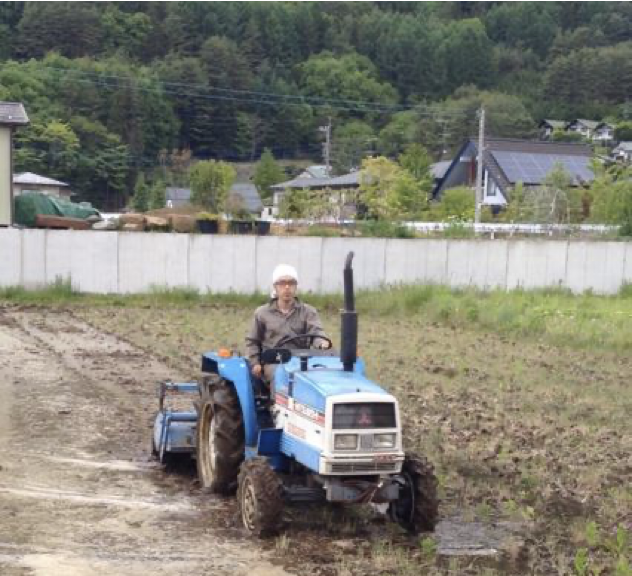

“Creating a new, self-sufficient social model.“
I left the Tokyo area following the Great East Japan Earthquake in 2011, and it all began when I started farming at the foot of Mount Fuji.


“Let’s distribute ‘food’ instead of ‘salary,’ not only in the event of a natural disaster but also when money cannot be used.“
In 2013, we established our base at the southern foot of the Yatsugatake Mountains (Hokuto City, Yamanashi Prefecture), an area abundant in nature and conducive to building a new society. Our goal was to create a corporate community that integrates agriculture with other business activities, known as ‘half-farming, half-X’.
When I visited Israel for the first time in 2014, I discovered the existence of self-sufficient agricultural communities (known as kibbutzim in Hebrew) thriving in the desert.

Israeli kibbutzim are not only self-sufficient through agriculture but also provide community support for child-rearing, advanced education, and facilities where the elderly can live in peace. Within this village society, regardless of status or individuality, everyone plays a role and helps each other, creating an ideal social model.
“A Japanese version of a kibbutz in Yatsugatake“
Seven years have passed since then. While dividing the roles between the business team (Yatsuha Co., Ltd.) and the agriculture team (Yatsugatake Peace Farm Co., Ltd.), we have supported the relocation of over 100 households and more than 200 people to Yatsugatake. Together with our friends who have also relocated to the southern foot of Yatsugatake, we launched
the “Kibbutz Yatsugatake General Incorporated Association”
in 2021 as a community management company.
The reason behind this was not only the need for space to accommodate the rapidly increasing number of migrants but also the fact that the COVID-19 pandemic led to a rapid increase in abandoned farmland. This resulted in more farmland to manage and the need for the support of many people to protect local agriculture.
Japan is facing a serious shortage of agricultural workers and an aging population, leading to an increase in abandoned farmland across every region. However, the issue is compounded when mega solar power companies or large-scale farms take over this abandoned farmland, often resulting in the spraying of large amounts of herbicides and chemical fertilizers.
At Kibbutz Yatsugatake, we practice natural farming, which means we do not use any pesticides, herbicides, or chemical or organic fertilizers during the production process.

We focus on the production of rice, the staple food of the Japanese people. Community members work together to produce more than 10 tons of rice every year without using pesticides or fertilizers.
Some members work in the rice fields every day, while others work only once a week or once a month.
Some people are unable to work in the rice fields even once a year, but regardless of the number of days they work, everyone is given the same amount of rice (60 kg) to last them for a year (basic inkome).
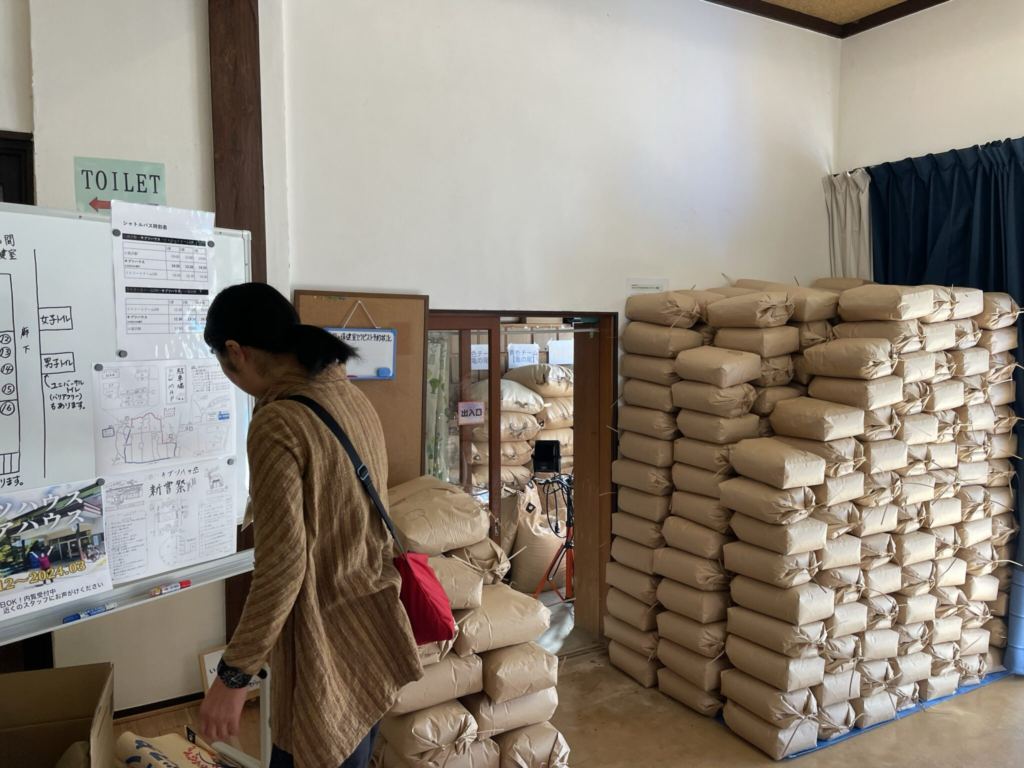
Kibbutz Yatsugatake began as a rice field community where members collectively manage the rice fields, regardless of their individual lifestyles.
In 2022, our second year since establishment, we began operating a community base called “Kibbutz House“. We have shifted to community activities that require each individual’s unique contributions and roles. Our members are now divided into various projects and teams, including food, clothing, shelter, education, and medical care.

Ultimately, we aim to create a community where people not only respect each other’s roles and contributions but also respect each other’s existence itself.
Ending Village

In the summer of 2022, Dr. Akira Kawashima, a specially appointed professor at the Department of Integrated Medicine, Kanagawa Dental University Graduate School, approached us with a proposal:
“Why not create an Ending Village in Yatsugatake?“
Simply put, the Ending Village is a modern-day version of “Ubasuteyama” (a place where the elderly are abandoned).
When we hear the term “Ubasuteyama,” we tend to think of a tragic story where elderly individuals, perceived as no longer useful, are abandoned in the mountains. However, the site of the mountain in “Dendera-no” in Tono City, Iwate Prefecture, which Professor Kawashima actually visited, was far from the image he had in mind.
In that village, once people turned 60, they would come to Dendera-no of their own volition to live in the community, leading a self-sufficient life and enjoying themselves without relying on their children.
During the day, they would come down from the mountains to help their children in the fields and rice paddies, and then return to Dendera-no at night. Far from being seen as useless elderly individuals, they were valued members who supported the next generation.
While searching for a new term to replace the original Japanese term “Ubasuteyama,” the term “Ending Village” was coined, referring to a community where people are mindful of death in their daily lives.

The Ending Village that Kibbutz Yatsugatake aims to create is
“a place where everyone can live out their final days in peace“
A place where everyone can live in peace is also a place where everyone can die in peace.
Facing death with peace of mind can make our mind peace.
“What is peace of mind?“
A convenient and safe location with minimal natural disasters?
A place with a large hospital and excellent nursing home facilities?
A location with many nearby family members?
No matter how safe a place is, if you cannot live authentically, it is not a society where you can find peace.
No matter how many family members you have close to you, you can never be sure if you will truly feel peace and comfort.
Even if you are not related by blood, as long as there is just one person who understands you for who you really are, you may feel more comfortable in an environment where you can freely reveal your true self.
If I am to be cared for at the end, I want it to be by a “family” with whom I have such a heartfelt (soulful) connection.
We do not simply mourn the loss of a loved one; we share a common perspective on life and death, and we wish to support each other in comprehending the meaning of death and the journey of the soul.
Shangri-La is a utopia where community members, with whom you have formed deep connections, can live together while still healthy, helping and caring for each other until the very end. It’s a place where one can live happily and peacefully until the final moments of life.
That is the concept of the “Ending Village” envisioned by Kibbutz Yatsugatake.
Community medical care is essential for people to feel safe and secure, so we focus on integrative medicine that includes alternative approaches like Ayurveda, the traditional Indian medicine.

Instead of relying solely on hospitals, medicine, and doctors, the villagers will learn integrative medicine, support each other, and care for each other until the end of life.
Of course, there will be times when we rely on medical intervention or Western medicine when it is truly necessary.
The approach to nursing care remains fundamentally the same.
The aim is for you to spend your final days in good health and without the need for intensive nursing care.
However, as we age, many tasks become increasingly challenging to perform naturally.

Unable to carry heavy loads, perform physical work, manage housework (cleaning, laundry, cooking), or drive a car, etc.
Even though it is an independent community, the top priority is to avoid forcing oneself to do tasks that are not manageable or suitable.
We will also establish a system aimed at fostering a society where those who are able and willing can support each other.
We will also establish a system where Ending Village members and specialized staff will be on the same premises or in the same facility to provide support for daily life.
The site will also include a midwifery clinic for natural childbirth, symbolizing a “beginning,” in contrast to the “ending” concept of the Ending Village. Additionally, there will be facilities for children, such as a nursery or alternative school, aiming to create an environment where people of all generations can interact.

Just as everyone is a “birth teacher,” we want not only midwives but all members of the community to be able to act as “birth doulas” to support women during pregnancy, childbirth, and the postpartum period (child-rearing).
Furthermore, rather than having only adults with specific qualifications as teachers in schools, we aim for “co-education by co-teachers,” where all adults and even children in the community can take on teaching roles and learn from each other.
We aim to achieve as much self-sufficiency as possible in terms of life necessities and services, circulating within the community. Eventually, instead of using dollars or gold, we plan to introduce a community currency based on rice, aiming to establish a local economic system that operates independently of the Japanese yen.
If energy self-sufficiency and production activities continue to expand in the future, we envision realizing a new social model where everyone can live prosperous and fulfilling lives without relying solely on money. This model aims to foster sustainability, allowing both people and the Earth to thrive in harmony.
Of course, achieving self-sufficiency and grounding is essential, but it is equally important to engage in activities that transform consciousness and enhance the spirituality of each community member. Therefore, we will also prioritize developing facilities and programs focused on meditation, yoga, and spiritual growth.
We hope that this future community will spread, connect, and cooperate not only in Yatsugatake but throughout Japan and the world, aiming to become a peaceful global community that transcends nationality, borders, ethnicity, and religion.
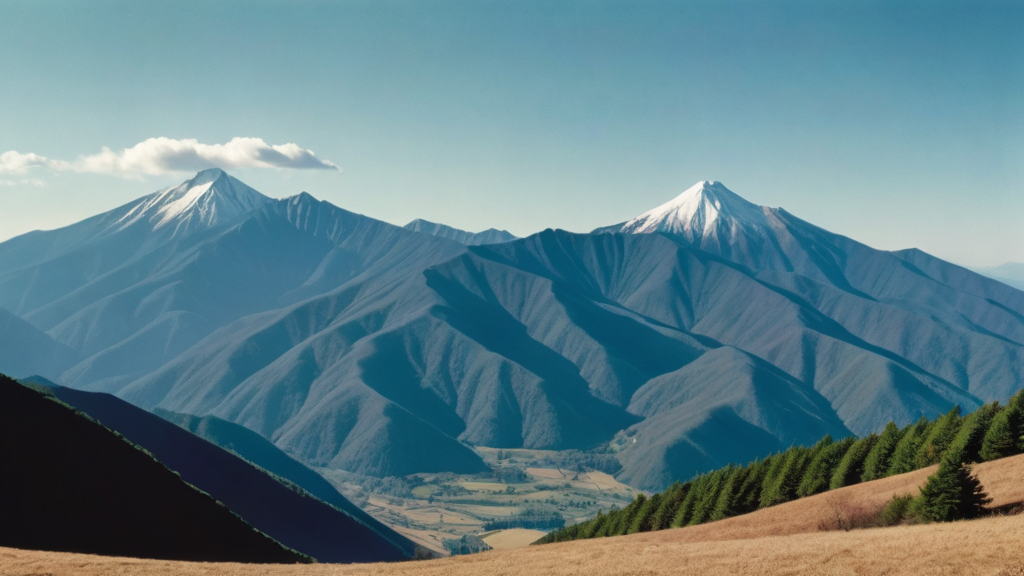
The appearance of a potential site of 33,000m²
The Israeli version of a kibbutz is a village that provides everything from food, clothing, shelter, and medical care to businesses within a single vast site.
In order to realize a Japanese version of a kibbutz that also incorporates the Ending Village concept, it was necessary to find a large piece of land. However, finding land that met the requirements at the southern foot of the Yatsugatake Mountains was not easy.
We finally found a 10,000 m² plot of land within walking distance of the community center.

Unable to purchase the property immediately, we searched for financial backers and finally found someone to support us. However, by the time we went to apply, the property had already been sold.
Next, we found a 9,000 m² plot of land being developed as a resort villa area in a slightly more distant location. However, despite our application, a mega solar company made a higher bid, and unfortunately, we were unable to acquire or protect the land.
More than a year had passed since the Ending Village project began without finding a suitable site, when suddenly, information came in about a 33,000 m² forest that was up for sale.

What’s more, the forest is right in front of the property of Yatsuha Co., Ltd. and the Takizawa family, which are at the center of the community. It’s a miraculous piece of land that is not just within walking distance, but incredibly close, just across the road.
“This is forestland owned by a large number of local people, so it’s unlikely to be sold.”
This place has long been known for such stories in the neighborhood, and in fact, in the last 11 years, I have never heard from a single landowner about it being up for sale.
Upon closer inspection, it turns out that the land is actually 33,000 m², which a resort development company in Tokyo had managed to assemble over many years by persuading numerous landowners one by one, with the intention of developing it into a large-scale luxury villa area.
After purchasing all of this land, the plan is to sell 13 plots for large housing developments, each ranging from 1,650 to 3,300 m², totaling approximately 300 million yen.
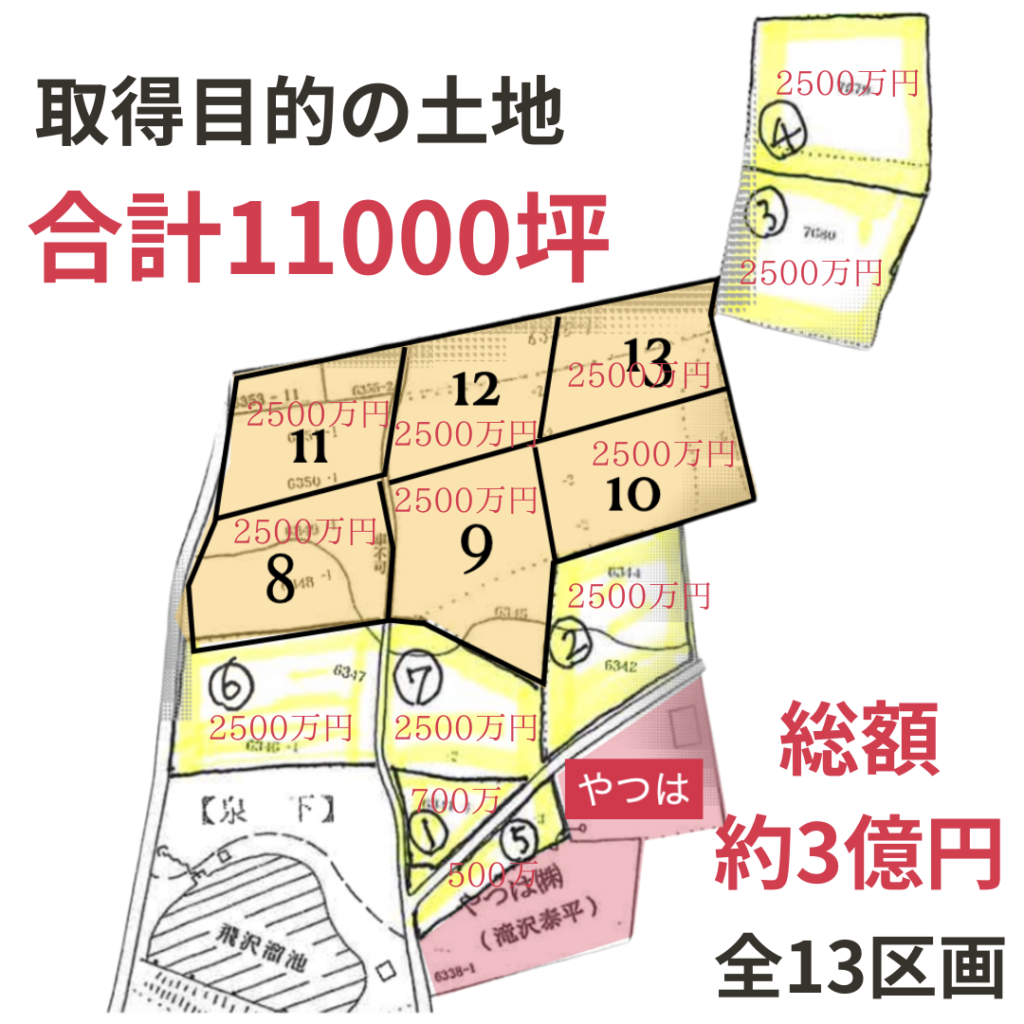
“Could you please wait a little while before selling it to outsiders so that we all have a chance to buy it?“
Even though we lacked access to the approximately 300 million yen in funding, we still went to negotiate directly with the president of the resort development company, and the words came out of my mouth.
Of course, I explained the Ending Village concept that I have described so far and asked if we could use the space for it.
As a result, the answer we received was,
“I’m willing to sell it to you if you purchase the entire plot.“
Finally, the site for implementing the Ending Village concept, envisioned as a utopia, was decided upon.
However, as I mentioned, we currently lack the funds to purchase all of them at the moment.
However, since we have made this commitment, we must ensure not to cause any inconvenience for the development company that has agreed to our conditions. Above all, this opportunity is crucial for realizing the utopia we have envisioned.
We have a vision.
We have the talent.
We have potential locations.
The only thing we are lacking is funding, and we cannot let that be the reason we give up on our dream. Therefore, we have decided to appeal to as many people as possible for their support.

Kibbutz Rice Foundation
If the entire 33,000 m² were developed into a large housing development with an Ending Village theme, there might be many people willing to purchase the land.
However, it is no longer in keeping with the times for each individual to own and manage newly constructed land and buildings, and various problems could arise in the future, especially regarding inheritance.
For this reason, we aim to acquire and manage the entire 33,000 m² under the name of the Kibbutz Yatsugatake, and to be frank, we are seeking to raise 300 million yen in donations.
As a community, we lack the funds to purchase land and currently do not have the ability to borrow money. Frankly, even if we could secure a loan, there is no guarantee that we would be able to repay it.
Furthermore, land acquisition is just the initial stage of our overall project plan; after acquiring the land, we will need to develop and operate various facilities and bases.


Expected facilities:
- Integrated medical hospitals and health treatment facilities
- Midwifery clinics, daycare centers, and schools for childbirth and early education
- Assisted living facilities for elderly residents
- Affordable rental housing for families with children
- Large cafeterias open to both residents and visitors
- Community facilities including event halls and auditoriums
- Local markets offering organic ingredients
- Large retail stores featuring organic products from around the world
- Natural hot spring facilities and accommodations
- Relaxing parks and outdoor theaters featuring broadleaf trees
- Ranch for interacting and coexisting with rescued animals
- Facilities for power generation and energy self-sufficiency for the entire site
This undertaking demands substantial funds, time, and energy far beyond the initial land purchase stage, so it’s prudent to reserve as much of our savings as possible for that phase.
However, raising such a large sum of 300 million yen in donations on our own is challenging.
So we decided to launch the
“Kibbutz Rice Foundation (Donation)”
project, which is not purely a donation without any return, nor strictly a loan, but rather something akin to crowdfunding—a hybrid of donation and loan principles.
Although donations will be managed through a general incorporated association, we plan to issue a
“Community Currency Exchange Certificate”
as a special benefit for donors to the fund. This certificate will allow them to receive vouchers exchangeable for
“Community Currency (Maica),”
a local currency intended for future use within the community site.
Maica is a community currency based on rice produced by Kibbutz Yatsugatake, intended for use within the services and facilities provided by Kibbutz Yatsugatake.
As the development of this 33,000 m² land progresses, there are plans to use Maica to fund various services on the site, including accommodation, dining facilities, and entrance fees for the Ending Village.
We are considering a variety of facilities for the elderly, ranging from options prioritizing individuals who live alone without relatives to those accommodating couples, and from shared housing to single-family homes.
There are facilities where occupancy rights can range from several million yen to over 10 million yen, while there may also be rental options available.
However, it has not yet been decided which services within the community currency will be available, and we will provide further details once the community currency project has been launched.
The exchange rate from the Community Exchange Certificate to Maica has yet to be determined, as it will depend on Japan’s economic situation and prevailing prices at the time Maica is issued in the future. However, we aim to offer services equivalent to the donated amount as much as possible.
The value of 10,000 yen today may not be the same as when Maica was first introduced; it could be worth 1,000 yen or 100,000 yen.
In either case, we will ensure that you receive services equivalent to the value at the time of your donation.
Please note that there is a limit of 5 million yen for issuing Community Currency Certificates per person; any donations exceeding this amount will be treated as regular donations.
Example: If you donate 10 million yen, you will receive a community currency exchange certificate for up to the limit of 5 million yen. The remaining 5 million yen will be treated as a regular donation.
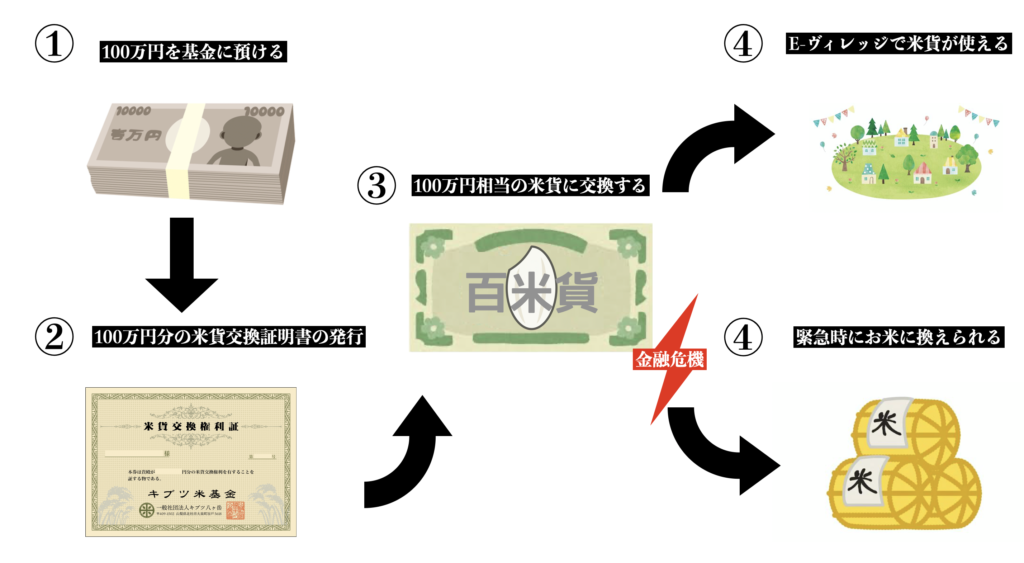
And the key feature of Maica is its special benefit:
“It can be exchanged for rice in the event of a financial crisis.“
The financial crisis here refers to a situation such as hyperinflation or similar occurrences in Japan or globally, where money loses its value, making it challenging to acquire safe food.
At that time, we aim to allow holders of Maica to exchange them for rice produced by Kibbutz Yatsugatake, proportionate to the amount of Maica they possess.
“It’s an era where having rice is more important than having money.“
So, the Kibbutz Rice Foundation serves as a “famine preparedness fund.”
Currently, with the kibbutz’s rice priced at 1,000 yen per kilogram, ensuring 300 million yen worth of rice would necessitate 300 tons.
Kibbutz Yatsugatake’s rice production in 2023 is 10 tons. Therefore, before we can guarantee 300 tons or accumulate such a stockpile, we aim to initiate this rice exchange system once we can secure a production volume of 30 tons.
It might be challenging to convey and comprehend everything solely through text.
We hope you will also watch our other explanatory videos. If you have any questions, please feel free to contact us for further inquiries or clarifications.
In the end, the land may become the property of Kibbutz Yatsugatake, but it is land that everyone involved has acquired. It represents our collective dream and will be a place where everyone’s aspirations can come to fruition.
Due to its position, Kibbutz Yatsugatake also needs to assume ownership. However, as we progress towards realizing this utopia, our ultimate goal is to aspire towards a worldview where we can transcend the concept of ownership, not just of this land.
Please lend us your support. Thank you very much.
General Incorporated Association Kibbutz Yatsugatake
Representative: Taihei Takisawa
《Application Process for the Kibbutz Rice Foundation》
- Please apply using the dedicated form.
- Transfer the money to the account listed in the automatic reply email.
- The Kibbutz Yatsugatake Office will contact you to confirm your payment and send you a PDF of the donation receipt to your registered email address. Please ensure you have received the email.
- After the Kibbutz Rice Foundation application period ends (June 21, 2025), your community currency certificate will be mailed to your registered address in order, approximately within one month. Please keep it safe.
Funding Guidelines
[Name of Corporation]
General Incorporated Association Kibbutz Yatsugatake
[Purpose of the Fund]
The funds will be used to acquire new land (33,000 m² in Oizumi-cho, Hokuto-shi, Yamanashi Prefecture) and cover the costs of applying for large-scale development to create a base for sustainable community activities by the Kibbutz Yatsugatake General Incorporated Association.
[Fundraising Plan]
- Planned Fundraising Amount: 300 million yen (30,000 shares)
- Amount per Fundraising Share: 10,000 yen
- Maximum Fundraising Amount: No limit (however, the limit for issuing Community Currency Exchange Certificates, described below, is 5 million yen per person)
- Fundraising Period: From June 21, 2024, to June 20, 2025
- Submit Fundraising Applications to: Kibbutz Yatsugatake General Incorporated Association
[Notification to Fund Contributors and Fund Payment Period]
- Method of Notifying Fund Contributors: Notification during June 2024
- Planned Fund Payment Period: June 21, 2024, to June 20, 2025 (Please transfer funds within one week of submitting the fund underwriting application)
[Target Contributors]
Anyone can contribute to the fund, regardless of nationality, age, or whether they are an individual or corporation.
[Place of Transaction for Fund Transfer]
The account will be at the financial institution designated by Kibbutz Yatsugatake General Incorporated Association. Transfer fees will be borne by the recipient.
[Provisions Regarding the Rights of Fund Contributors]
The fund will be treated as a donation.
Regarding Return of Funds
Contributors cannot request a return of their contributions.
Regarding the issuance of Community Currency Exchange Certificates
Contributors to the fund will receive Maica Exchange Certificates in proportion to the amount they contributed. However, there is a limit of 5 million yen (500 shares) for Maica Exchange Certificates per person.
Note: Maica is a local currency circulated exclusively within the community operated by Kibbutz Yatsugatake General Incorporated Association, intended for the following uses:
Examples:
- Right to use facilities in the community area (Ending Village, etc.)
- Use of facilities in the community area (hotels, restaurants, various services, etc.)
Scope and Validity Period of the Maica Exchange Certificate
The Maica exchange certificate obtained from the contributed fund is valid only for the person who contributed to the fund and cannot be transferred or sold. The validity of the Maica exchange certificate is unlimited.
Regarding the Expiry of the Maica Exchange Certificate
The Maica exchange certificate will expire under the following conditions:
- Abandonment of the Maica exchange right
- Exchange of Maica for rice
- Death of the contributor
- Dissolution of Kibbutz Yatsugatake General Incorporated Association
Regarding Exchange for Maica
The Maica exchange certificate can be redeemed for Maica at the exchange rate determined by Kibbutz Yatsugatake General Incorporated Association. The use of Maica will be governed by separate regulations issued at the time of Maica issuance.
Regarding Exchange for Rice
The Maica exchange certificate can be exchanged for rice (new or old) produced by Kibbutz Yatsugatake in emergency situations, such as hyperinflation caused by a global financial crisis, as determined by Kibbutz Yatsugatake General Incorporated Association. However, exchange for rice will only be possible once Kibbutz Yatsugatake’s annual rice production exceeds 30 tons.
FAQ
Q: I don’t need a Maica exchange certificate; I want to make a regular donation.
A: Please check “I do not wish to receive a Maica exchange certificate” on the application form.
Q: If I donate to the fund, will I be able to enter Ending Village?
A: Donating to the fund does not guarantee the right to live in the Ending Village facility. However, when construction plans for Ending Village are announced, fund supporters will be given priority in receiving information.
Q: When can I exchange my Maica Exchange Certificate for Maica? Also, is it possible to exchange it for Maica little by little?
A: You can exchange your certificate for Maica only once, and it will be possible to do so once the Maica service starts.
Q: If I donate 1 million yen to the fund, does that mean I will receive 1 million yen worth of services in the future?
A: Since the value of the Japanese yen may fluctuate in the future, you will receive services equivalent to the value of 1 million yen at the time of your donation.
Q: Why is the limit for Maica exchange certificates set at 5 million yen?
A: The limit is set at 5 million yen because there are many uncertainties surrounding the operation of Maica, and it is still a trial initiative.
Q: If Kibbutz Yatsugatake’s rice production is less than 30 tons and a financial crisis occurs, does that mean the rice cannot be exchanged?
A: Yes, if annual production is below 30 tons, we cannot guarantee an exchange for rice. Once production exceeds 30 tons, we will establish the details of the exchange rate between Maica and rice based on the situation at that time.
Q: Are there any plans to sell the 33,000m² lot for subdivision?
A: There are no plans to sell the 33,000m² lot for subdivision at this time. However, we do plan to sell neighboring land for subdivision. If you are interested in subdivision sales, please contact Yatsuha Real Estate.
Q: If I lose my Maica exchange certificate, can I still receive my Maica?
A: Yes, Kibbutz Yatsugatake also uses a digital management system, so you can still receive your Maica even if you lose your certificate.
Q: Is Maica a digital currency?
A: At this time, the specific details of Maica’s specifications have not been decided.

